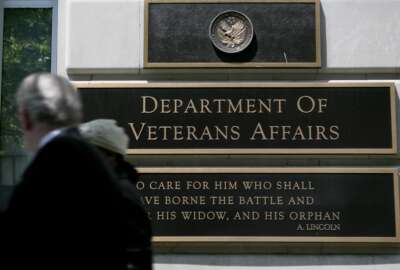

The Department of Veterans Affairs, facing an increased workload as more veterans seek VA health care and benefits, is prepared to significantly staff up under...
The Department of Veterans Affairs, facing an increased workload as more veterans seek VA health care and benefits, is prepared to significantly staff up under the Biden administration’s fiscal 2024 budget request.
The VA in its fiscal 2024 budget request is looking to grow its workforce to 453,834 employees — a more than 4.5% increase from current staffing levels.
Since 2019, the VA has added the equivalent of more than 78,000 full-time employees.
The Biden administration is proposing a $351.1 billion total budget for VA in 2024 — more than 5% increase over current spending levels.
The budget request is meant to support the VA as it takes on an increased workload under the PACT Act, which expands eligibility for VA health care and benefits to veterans exposed to toxic burn pits during their military service.
The White House, ahead of President Joe Biden’s recent State of the Union address, highlighted VA’s implementation of the PACT Act as part of a “unity agenda” to a divided Congress.
While Congress has yet to consider an actual spending plan for the next fiscal year, the VA is acting now on hiring and retention incentives contained in the PACT Act to grow its health care and benefits workforce.
VA Chief Financial Officer Jon Rychalski told reporters Thursday that the percentage of Veterans Health Administration staff receiving recruitment, retention and relocation incentives have more than doubled this year, compared to last year.
Rychalski said about 12.2% of VHA employees received some form of financial incentive so far this year, compared to 5.9% in 2022. Nearly one in five employees at rural VA medical facilities received an incentive this year, compared to 4.3% last year.
“This is just the tip of the spear. There’s a very full court press on recruiting and retaining staff,” Rychalski said.
VHA CFO Laura Duke said the VA’s budget request for 2024 takes into account new hiring flexibilities under the PACT Act.
“We’re very grateful for those flexibilities. Those are what enable us to deliver care within our facilities and really compete with the private sector, so we’re planning to utilize them to great effect in this budget and beyond,” Duke said.
VHA onboarded almost 13,000 new employees in the first quarter of 2022 — more than the same period of any previous year, and an 86% increase above the historical average.
Those incentives were particularly effective at bringing in housekeepers and food service workers at VA medical centers.
About 35% of VA housekeepers received an incentive this year, compared to 10.5% last year. Nearly 19% of food service workers at VA facilities received an incentive, compared to 2.1% last year.
The Veterans Benefits Administration, meanwhile, increased its total workforce by more than 5% in the first quarter of 2023, compared to a 1% growth in its workforce last year.
Charles Tapp, the Veterans Benefits Administration’s chief financial officer, said the agency is looking to hire upwards of over 6,000 additional employees. That’s on top of the 2,220 employees VBA brought on board last year.
Tapp said VBA is becoming more accommodating to remote work, which gives the agency “a broader pool of candidates.
“That certainly opens up the borders of VBA. They’re not geographically isolated [to] where we have a regional office, but allows us to potentially even be more broad, as we look for talent where it lives, as opposed to talent being where we live,” Tapp said.
The 2024 budget request also proposes a $1.9 billion budget for the continued rollout of the VA’s new Electronic Health Record from Oracle-Cerner. That’s about a 16% increase from current spending levels.
The Biden administration’s continued support of the troubled EHR rollout comes the same week that Republicans on the House VA Committee proposed the VA pull the plug on the Oracle-Cerner project, and instead focus on modernizing its legacy EHR VistA, which has been used by VA clinicians for 40 years.
“ERHM has certainly faced a lot of challenges, or some challenges, over the past year or two with various delays to the proposed rollout schedule,” said Andrew McIlroy, VA’s deputy assistant secretary for budget. “But this funding proposed for fiscal year 2024 seeks to balance what we can reasonably achieve, in terms of rollout with available funding.”
Rychalski said much of the funding request will support future EHR go-lives, but added that some of the 2024 budget would help pay for “sustainment costs” for the new EHR that’s already running at five VA sites.
“What we’re finding is, in some cases, work has slowed down on the actual deployment, but in other areas, costs that we had anticipated are starting to come into play,” he said.
The White House 2024 budget request would give the VA $6.4 billion to VA’s Office of Information and Technology (OIT).
The funds would help the VA modernize its cybersecurity, modernize IT systems and accelerate the use of automation tools to process a record number of benefits claims this year.
VA OIT would receive an additional $1.2 billion from the Toxic Exposures Fund set up under the PACT Act.
The administration’s topline budget request includes $600 million the VA has saved in its Recurring Expenses Transformational Fund, which consists of expiring congressional appropriations.
Rather than send those unspent funds back to the Treasury, Congress allows the VA to spend those expiring appropriations for IT and infrastructure costs. The VA plans to spend all $600 million in the fund on major construction projects.
Copyright © 2025 Federal News Network. All rights reserved. This website is not intended for users located within the European Economic Area.
Jory Heckman is a reporter at Federal News Network covering U.S. Postal Service, IRS, big data and technology issues.
Follow @jheckmanWFED



